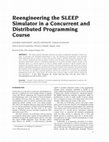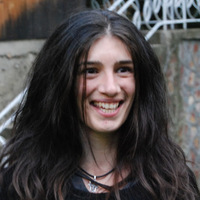Papers by Milos Cvetanovic
Serbian Journal of Electrical Engineering, 2015
2014 22nd Telecommunications Forum Telfor (TELFOR), 2014
Information and Software Technology, 2015
2011 Second Eastern European Regional Conference on the Engineering of Computer Based Systems, 2011
This paper presents a general purpose discrete event simulator, named SLEEP, that helps students ... more This paper presents a general purpose discrete event simulator, named SLEEP, that helps students to bridge the gap between theory and practice in the domain of Computer Architecture and Organization simulator design. The motivation for developing SLEEP is given after an analysis of simulators available in the open literature. The analysis is followed by implementation details explaining execution and simulation
2012 20th Telecommunications Forum (TELFOR), 2012
2011 19thTelecommunications Forum (TELFOR) Proceedings of Papers, 2011
Serbian Journal of Electrical Engineering, 2013
IEEE Transactions on Education, 2000
This paper presents a Web-based educational system, ADVICE, that helps students to bridge the gap... more This paper presents a Web-based educational system, ADVICE, that helps students to bridge the gap between database management system (DBMS) theory and practice. The usage of ADVICE is presented through a set of laboratory exercises developed to teach students conceptual and logical modeling, SQL, formal query languages, and normalization. While working on the exercises, students use the system to access real databases, and the system provides them with feedback about their solutions. From the perspective of an instructor, the system allows easy exercise management and continual progress monitoring. The paper also describes a practical experience with the use of ADVICE on a database course over a three-year period.

Computer Applications in Engineering Education, 2014
This article presents laboratory exercises and project assignments developed to teach concepts of... more This article presents laboratory exercises and project assignments developed to teach concepts of concurrent and distributed programming in Java. The exercises and assignments cover important topics determined after an analysis of topics that are often taught in different universities. During the exercises, students reengineer the general purpose discrete event simulator named SLEEP (Simulation, Logic, Execution, prEsentation, Physics). A multilayer organization of the SLEEP simulator enables coverage of the important topics in a coherent manner. In order to support parallel execution in SLEEP students start to reengineer the simulator layers with an exercise related to concurrent programming, followed by two exercises related to distributed programming, and finish with an exercise related to grid computing. The exercises follow the principles of error management training and teach students what common errors are and how to overcome them. The article also describes a practical experience with the use of SLEEP on a concurrent and distributed programming course over a 3-year period. The results show a positive impact on both students' satisfaction and performance. ß

Proceedings of the 11th International Language Resources and Evaluation Conference (LREC 2018), May 10, 2018
Although the task of semantic textual similarity (STS) has gained in prominence in the last few y... more Although the task of semantic textual similarity (STS) has gained in prominence in the last few years, annotated STS datasets for model training and evaluation, particularly those with fine-grained similarity scores, remain scarce for languages other than English, and practically non-existent for minor ones. In this paper, we present the Serbian Semantic Textual Similarity News Corpus (STS.news.sr) – an STS dataset for Serbian that contains 1192 sentence pairs annotated with fine-grained semantic similarity scores. We describe the process of its creation and annotation, and we analyze and compare our corpus with the existing news-based STS datasets in English and other major languages. Several existing STS models are evaluated on the Serbian STS News Corpus, and a new supervised bag-of-words model that combines part-of-speech weighting with term frequency weighting is proposed and shown to outperform similar methods. Since Serbian is a morphologically rich language, the effect of various morphological normalization tools on STS model performances is considered as well. The Serbian STS News Corpus, the annotation tool and guidelines used in its creation, and the STS model framework used in the evaluation are all made publicly available.











Uploads
Papers by Milos Cvetanovic